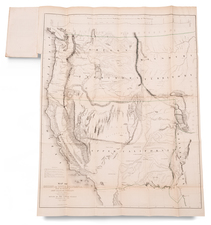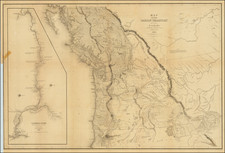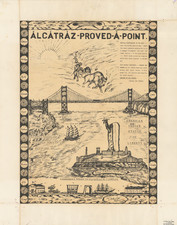The First English Map of the Coast of California
This is the exceptionally rare English version of Miguel Costansó's 1770 chart of the coastline of California, itself titled Carta Reducida del Oceano Asiático ó Mar del Súr Que comprehende la Costa Oriental y Occidental de la Penísula de la California, which was compiled by Alexander Dalyrmple from a Spanish manuscript example of Costanso's map, augmented by profile views not present in the original Spanish manuscript.
The map ranges from Rio de los Reyes - Point Reyes at about 40 degrees north to Cabo de Corrientes at about 20 degrees north and is further embellished with a panel of approximately 13 coastal profiles across the top, attributed by Dalrymple to a French manuscript journal by M. Savague le Muet, aboard the Comtess de Ponchartrain in 1714. The Comtess de Ponchartrain was the first ship to circumnavigate the globe from west to east, touching on the Marias Islands south of Cabo San Lucas in 1714 after crossing the Pacific from China and Japan.
This English version of the map, published by A. Dalrymple in London in 1790, is notable for being the second printed map to depict San Francisco Bay and the first to cover the Coast of California. The original Costanso map, dated 1771, and this English edition are both extremely rare. The chart reflects the actual configuration of the California coast as far north as Point Reyes, based on observations. It is the first such chart to attempt a mapping of the Coast of California since the mapping of the coast by Vizcaino in 1603.
The original Spanish edition of the map was drawn by Miguel Costanso, a royal engineer who accompanied the 1769 expedition led by Captain Gaspar de Portola. This expedition was meant to establish a settlement at Monterey Bay, which was discovered by Vizcaino in 1603. The Portola expedition, travelling by land from San Diego, discovered the lower arm of San Francisco Bay in November 1769. However, the entrance to the bay was not observed, so its position on the chart is based on conjecture.
Costanso's map, drawn using records from the expedition, was sent to Madrid, where it was engraved by Royal Geographer Tomas Lopez and printed by Hipolito Ricarte in 1771. However, due to Spanish secrecy, the chart was not widely circulated, and knowledge of the great bay was not diffused for some time.
In 1790, Alexander Dalrymple acquired Costanso's map and published a copy, including profile information derived from a contemporary manuscript of a French expedition, which Dalrymple does not identify further. In the Advertisement, Dalrymple notes:
I have added, to the Map of California by Don Miguel Costanso, the Engineer on this Expedition, some Views of the Coast, from a French MS Voyage in my possession, and have joined, to compleat the Knowledge of the Parts herein mentioned . . .
The map was compiled to accompany Dalrymple's translation of Costanso's 1770 account, which was published under the title An Historical Journal of the Expeditions, by Sea and Land, to the North of California in 1768, 1769 and 1770: when Spanish Establishments were first made at San-Diego and Monte-Rey. From a Spanish MS Translated by William Revely, Esq., published by Dalrymple in 1790. The manuscript was reportedly furnished to Dalrymple by " the celebrated historian", Dr. Robertson, who furnished the manuscript to Dalrymple in 1783.
Rarity
We note a single example on the market in the past 40 years (Warren Heckotte copy, acquired at Sothebys June 25, 1987.
Dalrymple's Historical Journal of the Expeditions . . . is also exceedingly rare. The last examples on the market were Sothebys 1984 and the Streeter copy in 1968.
Transcription and Translation of Text
CARTA REDUCIDA del OCEANO ASIÁTICO & MAR DEL SUR
Que comprehende la Cofta Oriental y Occidental de la Penínfula de la CALIFORNIA, con el Golfo de su Denominacion antiguamente conocido por La de MAR DE CORTES,y de Las Coftas de la AMÉRICA SEPTENTRIONAL desde el Ifthmo que une dicha Peninfula con el Continente hasta el Rio de los Reyes, y desde el Rio Colorado hasta el Cabo de Corrientes.
Compuesta de Orden del Ex Señor Marqués de Croix, Virrey, Governadory Capitan General del Reyno de la Nueva Efpaña, y de los Exercitos de S.M.
Les materiales que han servido á la formacion de esta larta son en primer lugar los diarios de los Pilotos que han navegado en el Mardel Sur, en los últimos vinges hechos a la California y al Norte de ella, á los Puertos de S.Diego,y Monterrey,con especialidad los de D.Vicente Vila Piloto del Num. de primeros de la Real Armada, y Comandante de los Paquebotes de S.M.destinades a la Expedicion Maritime que se dirigió a dichos Puertos y los diarios de Navegacion del Paquebote el S.Antonio en su viage hecho en el presente año de 1770.con el proprio objeto de dicha expedicion, la qual ha tenido éxito tan feliz que habiendo este mis- mo Paquebote el S.Antonio llegado á 31 de Mayo de 1770.al Puerto de Monterrey, y hechado ancoras en el proprio Puerto y fondeadero donde 168 años antes estubo surta la Esquadra del General Sebastian Vizcaino, embiada al descubrimiento de estas Costas por el Conde de Monterrey de orden del Señor Felipe III; y habiendo tambien llegado por tierra en 23 del citado mes y año la tropa destinada al mismo fin, se ha fundado en Monterrey un Presidio y Mision con la advocacion de S.Carlos y se forman iguales establecimientos en los fertiles paises por donde transitó la gente de la cxpedicion señaladamente en el Puerto de S.Francifco ocupado ahora de nuevo por los nuestros. Han contribuido á lo mismo algu nos fragmentos manuscritos de la Costa interior y exterior de la California hallados entre los papeles de sus antiguos Misioneros con explicaciones relativas alasunto y otros documentos franqueados por al- gunos particulares de orden de este superior Govierno concernientes á la Costa de Sonora:por último las noticies adquiridas por el autor en sus viages de Mary Tierra rectificados por varias observaciones hechas en los Lugares y terreno que ha corrido
Mexico y Octubre 30 de 1770 Miguel Costansó.
Translation:
Reduced Map of the Asian Ocean & South Sea
That comprises the Eastern and Western coasts of the Peninsula of California, with the Gulf of its denomination formerly known as the Sea of Cortes, and the coasts of North America from the Isthmus that joins the said Peninsula with the Continent to the River of Kings, and from the Colorado River to the Cape of Currents.
Composed by order of the former Lord Marquis de Croix, Viceroy, Governor, and Captain General of the Kingdom of New Spain, and the armies of His Majesty. The materials that served for the creation of this map are, in the first place, the diaries of the pilots who have navigated the South Sea, in the last voyages made to California and to the north of it, to the Ports of San Diego and Monterey, especially those of Vicente Vila, First-rate Pilot of the Royal Navy, and Commander of His Majesty's packets destined for the Maritime Expedition directed to said ports, and the navigation diaries of the packet ship San Antonio on its voyage made in the present year of 1770, with the same purpose of said expedition. An expedition that was so successful that this very packet ship, San Antonio, arrived on May 31, 1770, at the Port of Monterey and anchored in the very port and anchorage where, 168 years earlier, the fleet of General Sebastian Vizcaino had been stationed, sent to discover these coasts by the Count of Monterey on the order of Lord Philip III; and having also arrived by land on the 23rd of the mentioned month and year, the troop destined for the same purpose founded in Monterey a Presidio and Mission under the patronage of St. Charles, and similar establishments are being formed in the fertile countries through which the expedition's people passed, notably in the Port of San Francisco, now newly occupied by ours. Some manuscript fragments of the inner and outer coast of California found among the papers of its ancient missionaries have also contributed, with explanations related to the subject and other documents provided by some individuals by order of this superior Government concerning the Coast of Sonora: finally, the notices acquired by the author in his sea and land journeys, rectified by various observations made in the places and terrain he has traversed.
Mexico, October 30, 1770, Miguel Costansó.
Alexander Dalrymple (1737-1808) was a skilled hydrographer. He was born near Edinburgh and was the son of a Member of Parliament. As a teenager, Alexander—the eleventh of fifteen children—began a career with the East India Company (EIC). He worked as a writer for the Company and was posted to Madras in 1753. There, he rose to the position of sub-secretary and researched the English trade with Burma, Indo-China, and Borneo, quickly becoming an expert in Maritime Southeast Asia.
While a Company servant, Dalrymple sailed on three voyages around the Philippines, Borneo, Sulu, and other islands. He was testing hydrographic hypotheses, accessing archives, and making new charts on all of these voyages. In 1763, he resigned from the EIC and began a return trip to London, where he sought to promote a new trading opportunity at Balambangan. On his way home, he was named provisional deputy governor at Manila in April 1764, as the British then held the archipelago.
Back in London, Dalrymple continued to research the geography and hydrography of the South Seas and the East Indies. He published several works, including An Account of the Discoveries Made in the South Pacifick Ocean Previous to 1764 (1767) and An Historical Collection of the Several Voyages and Discoveries in the South Pacific Ocean (1769-71). The former of these made him the Royal Society’s preference to lead the South Pacific leg of the Transit of Venus observations of 1769; the Admiralty preferred a naval officer and chose Lieutenant James Cook instead. In both of these works, Dalrymple championed the hypothesis that there was a massive southern continent counterbalancing the northern continents.
Dalrymple also published many charts at this time, and he continued to lobby for a trade settlement at Balambangan. However, a disagreement with the EIC meant that he was removed from the proposed expedition to the island. In 1774, he began to publish his series of Plans of Ports in the East Indies, complete with sailing directions. Thanks in part to this successful venture, he managed to regain employment with the EIC in 1775, returning to Madras. There, he was ensnared in a scandal involving the Madras council which necessitated his return to London in April 1777.
On the return voyage, Dalrymple used a John Arnold chronometer and became an advocate for renewed and precise calculation of longitude to both signal the best routes during the proper seasons and to revise charts. He convinced the EIC to employ him on correcting their charts and publishing new ones, which he began to do in 1779. In the same year, he proposed a project that would create coastal charts for EIC ships from the Mozambique Channel to China. To this end, Dalrymple began publishing new charts annually. In fifteen years, Dalrymple published 550 plan and charts, 45 plates of coastal views, and nearly sixty books and pamphlets on navigation.
A Fellow of the Royal Society since 1771, Dalrymple was at the heart of a large circle of savants interested in geography. He was a close friend of Joseph Banks, James Rennell (with whom he had sailed in the East Indies), and William Marsden. Dalrymple contributed to the compilation of charts for the Vancouver expedition in the early 1790s, just one sign of his close relations with various branches of the government and the elite.
In 1795, his skills, erudition, experience, and social ties led him to be named as the first head of Britain’s newly-created Hydrographic Office (HO). His main task at this time was to sort the existing chart collection, while also evaluating the charts’ continued utility. By 1800, the HO was also tentatively engraving their own charts, although not performing their own surveying expeditions. While at the HO, Dalrymple proofed over 150 charts, as well as reprinted many of this own EIC plates, which by 1804 numbered 817. In 1806, Dalrymple published his EIC charts and sailing directions together in geographically-themed volumes, the Collection of Nautical Memoirs and Journals.
Things were not all rosy, however, as Dalrymple clashed with officials at the Admiralty over confidentiality of unpublished foreign charts and the direction of the HO. The Board of Admiralty fired him in late May of 1808. He died only three weeks later, on June 19, 1808.
In addition to the hundreds of charts he created in his lifetime, his personal working library was considerable. This library went on to form the core of the Admiralty library and of the HO’s own book collection. The Admiralty also bought over 400 of his copper plates, many of which were re-issued as Admiralty charts.











![[ Southern California ]](https://storage.googleapis.com/raremaps/img/small/98827.jpg)
![[Berkeley] This Is The Map of Berkeley Town Its Streets Go Winding Up & Down An Oak-Covered Campus It Wears For A Crown With People & Places of Renown](https://storage.googleapis.com/raremaps/img/small/97201.jpg)

